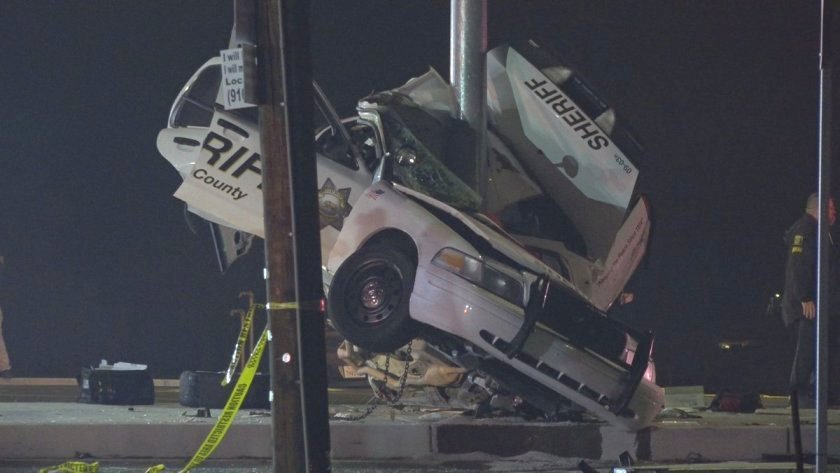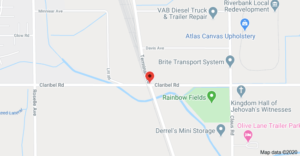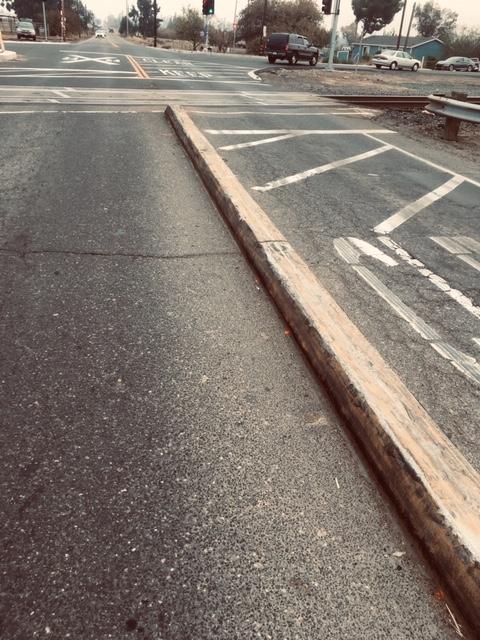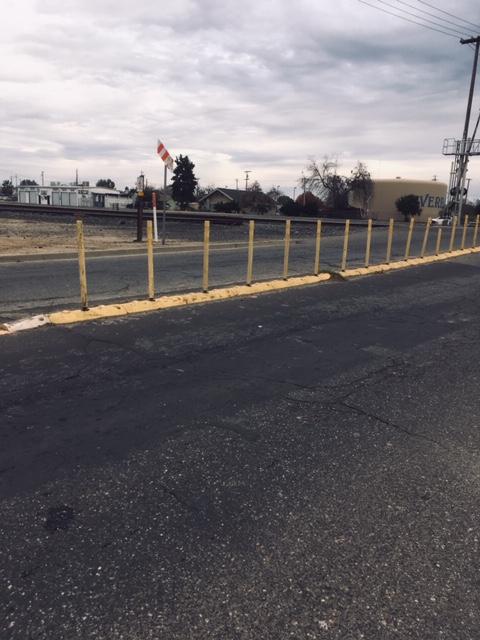Steve Ringhoff is an independent investigative journalist. See more of his stories here.
Stanislaus County Sheriff’s Deputy Antonio Hinostroza was killed when his patrol car slammed into a signal pole at Claribel and Terminal south of Riverbank on November 25, 2018 while speeding to join in the pursuit of a drunk driver.
This week, the Central Division of the California Highway Patrol (CHP) released a 219 page final report fulfilling a public records act request made many months ago. More than 58 pages of that report were redacted—blacked out—including virtually all of the opinions and analysis portions created by its specialized accident investigation team. (A discussion regarding the redactions and my response will follow this story.)
We are left with a detailing of facts regarding the crash with a jump to conclusions which fault Deputy Hinostroza and ignore any role played by roadway conditions — conditions which could explain why the deputy lost control of his car and was unable to regain it.
We now have more detail about the deputy’s actions leading up to the crash, although some of those details appear contradictory, given the redactions.

Deputy Hinostroza came on duty at 7:00 pm, left the sheriff’s facility south of Modesto at 8:00 and was in the Village One subdivision on Sagemill Drive north of Glencrest at 9:52, when he was called to join in a pursuit of a suspected drunk driver.
A couple of minutes earlier, the police dispatcher got a call about someone apparently passed out in a car near Oakdale and Patterson Roads, just west of Riverbank. When the first deputy arrived, the Cadillac Escalade sped away and the chase was on.
Trailing the chase, or trying to intercept it — which option isn’t clear — Deputy Hinostroza wended his way out of the subdivision’s warren of residential streets, finally getting onto Sylvan and then onto Roselle.
On Roselle, south of Claribel, the CHP narrative section of the report has him going 109 mph. However speed data in another un-redacted portion of the report has him going about 20 mph slower. Neither speed would be uncommon when involved in a chase with red lights flashing and siren screaming, according to a survey of chase reports done recently.
After turning right onto Claribel the Deputy was going 77-83 mph and he was approaching a unique roadway object, perhaps dangerous in design as well as when not properly maintained, as was the situation that NIGHT.
I emphasized the word “night” because this was a nighttime crash and as best we can tell, the CHP’s crack accident investigation never made an effort to see what Deputy Hinostroza would have/could have seen as he approached the intersection of Claribel Road and Terminal Avenue.
 This is an intersection made awkward by the proximity of the intersection with the BNSF Raidlroad tracks which parallel Terminal and cross Claribel. According to records from 2014, 30 freight trains and a dozen passenger trains go through this crossing daily. At that time Claribel had an average daily traffic count of 10,140 automobiles, east and westbound.
This is an intersection made awkward by the proximity of the intersection with the BNSF Raidlroad tracks which parallel Terminal and cross Claribel. According to records from 2014, 30 freight trains and a dozen passenger trains go through this crossing daily. At that time Claribel had an average daily traffic count of 10,140 automobiles, east and westbound.
In the past, the intersection was controlled by four-way stops for vehicle traffic at the intersection itself and flashing lights and arm barriers controlling Claribel traffic as well.
There was a real or perceived problem when traffic backed up on eastbound Claribel, especially when a train was approaching. It was thought that cars would cross the double yellow line on eastbound Claribel to go around the line of cars, perhaps to beat the train.
So, a corrective project was begun in 2014 and completed in April of 2016. The project, reflected in, “as built plans,” coordinated the intersection signals with the crossing arms and flashing lights of the railroad crossing, put a number of islands at the intersection to channel traffic through turns at the intersection, and installed a raised median barrier between the eastbound and westbound lanes west of the tracks (photo).
It is this barrier that certainly played a role in the fatal crash. That is without controversy. The collision between the left side tires and the barrier caused the loss of control of the Crown Victoria Hinostroza was driving. Why the Deputy didn’t avoid the collision with that barrier is what is at issue.
The plans call for a concrete barrier 8 inches high, 11 inches wide at its base and 9 inches wide at the top. The barrier was 150 feet long. It was supposed to be painted with reflective paint and delineators ( approximately 3 foot high plastic pipes) mounted along the top of the barrier.
At the time of the crash, photographs show and the CHP noted, the yellow paint was faded and degraded and the delineators were gone. The CHP noted markings along the length of the barrier from collisions with the barrier, including tire rubbings. There were at least two accidents in the years between the project completion and our crash involving the barrier.
(The County, in a written answer to questions from the CHP said that a modular median barrier with delineators had been installed in 2012 where the 2016 project barrier was to be constructed by Reid Engineering; the plans said the barrier was replacing striping, not an existing barrier. As we will see, if a modular barrier was in place before, perhaps that’s what should have been there as the deputy approached.)
So, Deputy Hinostroza is behind the wheel of that patrol car. He is going eastbound on Claribel at 77-83 mph, lights flashing and siren sounding, the street markings consist of a white edge line to the right and a double yellow centerline.
Additionally, the eastbound lane is substandard in width. It measures between 10 and 11 feet. A standard freeway lane is at least 12 feet wide and much wider if there is a curb at the edge.
As he nears the Terminal Avenue intersection he has to make a decision whether to turn right onto Terminal of go straight through the intersection. It would seem that he planned to go straight, otherwise he would have slowed. The right turn onto Terminal is sharp, and right after crossing railroad tracks.
 What does he see in his headlights? We know what he doesn’t see. He doesn’t see delineators and he doesn’t have the benefit of reflective paint on the barrier. It is certainly conceivable that what he thought was ahead was just a continuation of the center stripe.
What does he see in his headlights? We know what he doesn’t see. He doesn’t see delineators and he doesn’t have the benefit of reflective paint on the barrier. It is certainly conceivable that what he thought was ahead was just a continuation of the center stripe.
The CHP, in laying all the blame on the deputy, postulates that at about the time he was approaching the barrier he was momentarily distracted because he made an entry into his patrol car’s computer — he pushed a button which noted he was “enroute.” This, the CHP says, caused him to drift to his left, allowing his car’s left side tires to strike the barrier.
The question unanswered, at least in that portion of the report not blacked out, is whether the deputy would have done anything but focus straight ahead if he had been given any visual clue that the barrier existed.
It is in this aspect of the reconstruction that there is an apparent deficiency. The CHP notes that the sight distance is basically, for all practical purposes, unlimited IN DAYLIGHT. But, this crash was not in daylight. So, we have to question why no effort was apparently made to determine what the deputy could have seen.
Maybe the CHP team did make such a visibility study. If so, when they assessed fault, you would have expected that the visibility of the barrier would have been discussed and dismissed. They have assumed what was in the deputy’s head without trying to determine what the Deputy saw, or didn’t see, or could see.
Those portions of the report provided are not critical of the roadway even though the barrier is unusual and was clearly not maintained as intended. One member of the CHP team is a Caltrans engineer. His analysis and opinions, if any, are not disclosed in the CHP report.
This median barrier is different than seen in similar settings. There are a number of barriers in use which cause less interference with a driver’s ability to control the car if the barrier is encountered. An example is the very next roadway crossing to the north, the Patterson Road BNSF crossing.
 This crossing has delineators which were just like those originally placed atop the barrier on a Claribel but which were not maintained. The CHP asked the County for maintenance records for the barrier, but the county apparently could not produce any.
This crossing has delineators which were just like those originally placed atop the barrier on a Claribel but which were not maintained. The CHP asked the County for maintenance records for the barrier, but the county apparently could not produce any.
The delineators aside, the barriers are different in two other aspects, height and width. A car which strayed over the barrier on Patterson Road could easily steer back into the lane of traffic.
That would not be possible on Claribel. In our crash, the patrol car struck the end of the barrier, 11 inches wide, with both left side tires. They were flattened on impact, the steel rims deeply indented, and the patrol car straddled the barrier. Even if they had not been flattened the patrol car would still have been stuck on the wrong side of the barrier.
According to published specifications for the 2009 Crown Victoria, the minimum ground clearance is less than 6 inches and the barrier is 8 inches high. So the sedan was “high centered” on the barrier.
The CHP concluded, as I postulated in an article a few days after the crash, that as his patrol car scraped along the barrier, the deputy tried to turn back to the right. This steering input caused the sedan to veer to the right once it cleared the barrier, and sent it into the signal light pole. Deputy Hinostroza was killed instantly.
It was apparent to just about everyone that the barrier played a significant role in this tragedy. County public works’ crews were out within days repainting the barrier that bright yellow paint and installing a reflective paddle marker at each end. It wasn’t long, however before one of those markers disappeared, evidence that cars or trucks were still rubbing alongside or over the concrete.
While the exact set of circumstances is unlikely to present itself in the future, something similar could occur. Now that traffic lights have replaced the stop signs at the intersection, traffic can flow through the intersection at relatively high speed. And, given the narrow eastbound lane, striking that 8 inch high barrier would be unpleasant, at least.
This question has to be asked: Why not use the same device, a much lower barrier with delineators, as is being used at the Patterson Road crossing, the next BNSF roadway crossing to the north, instead of an 8 inch high concrete barrier (rebar reinforced). The height of the barrier damages any car which strikes it end-on and the height precludes recovery into the eastbound lane.
Fair conclusion by the CHP, or not?
On trying to get the information: The vehicle code allows a “person with a proper interest” to obtain a copy of the entire report. That code section lists persons who have a proper interest but the language also says the listing is “not limited to” those enumerated. We believe a journalist has a proper interest in this report because it involves the death of a public employee, killed on duty and with the possible involvement of a defect in a public roadway. After receiving the report with 58 redacted pages, we wrote to the Central Division Chief, listing the reasons why the report should include the additional information. We have received a response from the chief of the Office of Risk Management denying any additional information because we are not specifically listed in the section. The chief goes on to quote a provision of the law which says the CHP is not required to disclose the investigator’s analysis and opinions.
Right, not required to disclose, not forbidden to disclose.
We have been trying to obtain this report since March of 2019. The report itself says it was “released for publication” in a December of 2019. We received the report on July 9.

My personal opinion is the county is at fault for not completing the work, and not keeping up with the safety reflective tape.
I drive that road all the time and it doesn’t have the best of lighting. I can only imagine how dark it was the night without stop lights.
Did anyone ever check to see when the Deputy Hinostroza was last assigned in that area? Maybe the last time he drove in the area, the raised concrete barrier wasn’t there☝️
Yes, sounds like they owe a serious explanation &/or answers to the questions/concerns you raise!! The fact that it was a Deputy Sheriff, a public employee, is even more shameful, not merely to the county & its citizens, but to the officer’s family!! What a slap in the face! As I said, shameful!